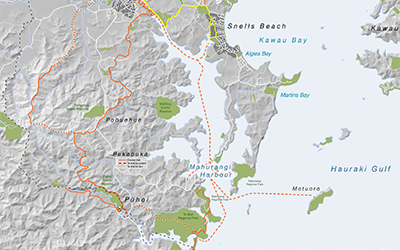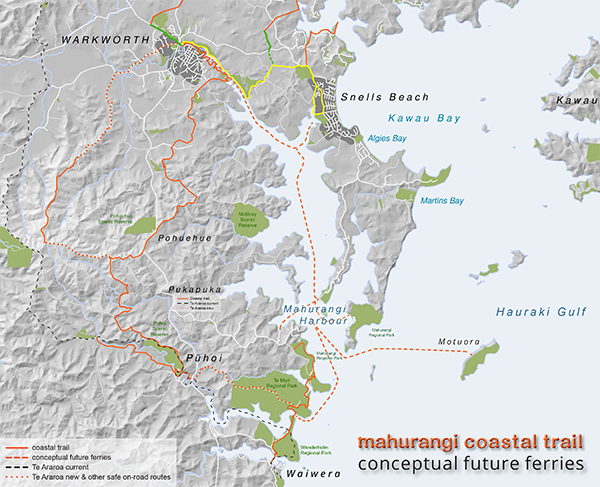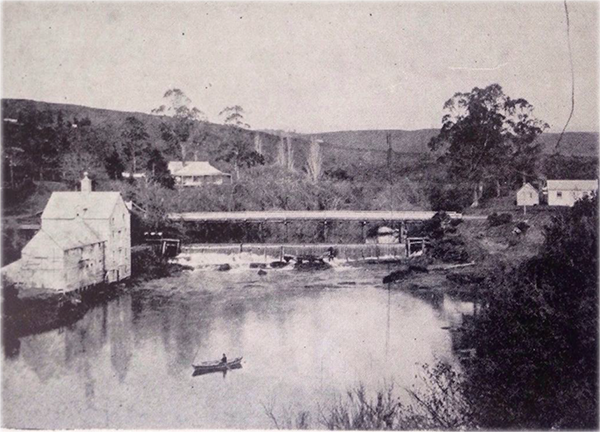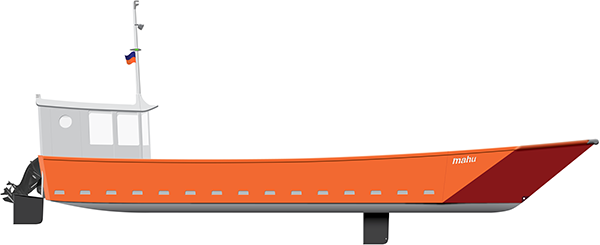Fourth Thursdays 3rd time lucky after 20 June


Ferries Future of Mahurangi Coastal Trail: Although it is possible that, in the fulness of time, the Pūhoi Estuary will be crossed via footbridge, ferries are key to opening the Mahurangi Coastal Trail and making it one of Auckland’s most-loved walks. map Morphum Environmental |Mahurangi Magazine
The clash wasn’t discovered until after 20 June was locked in for the Mahurangi Coastal Trail Taking Shapely town-hall talk.
Having cheerfully ceded their second-Wednesdays slot to bpw Warkworth, the town-hall talks have found that third Thursdays also clash. Which wasn’t apparent until this season’s first Forest and Bird Winter Talk, leaving no mealtime for those wishing to attend the town-hall talk at 5.30 pm then the winter talk at 7.30, out at the Tōtara Park Village Hall.
Further compounding the potential for confusion, the Mahurangi Matters article accompanying the town-hall talk advertisement, in the newspaper’s printed edition, gives the date as this Monday’s, rather than 20 June. Hopefully folk interested will be sufficiently discombobulated by the anomalous Thursday 10 June printed, to spot the correct date—20 June—prominent at the foot of the same page.
Fortunately for the town-hall talk organisers—Mahurangi Action and One Warkworth—speakers scheduled for the balance of 2019 have readily responded to the new, fourth-Thursdays slot. Particularly fortunate, was that the August speaker, on the Historical Archaeology of Coastal Trade on the Mahurangi, despite being currently Wellington-based, was able to reschedule. Had anthropologist Bree Wooller still been attending the University of Ōtago, where she presented her dissertation, the clean switch to fourth-Thursdays, after Thursday week’s talk, might not have been possible.

Covering Multitude of Mahurangi Icons: Even in this indistinct image, the petite martini-glass transom of the iconic Mahurangi punt is evident. Fossil fuel and roads might have belatedly relegated the Mahurangi River to a mere scenic backdrop to its tidehead town, but unstoppable, irreversible multi-metre sea-level rise will inexorably restore the relevancy of flat-bottomed boat access. dissertation cover image Historical Archaeology of Coastal Trade on the Mahurangi
Fossil-fueled steam power was slow to replace sail on the New Zealand coast, as evidenced by the commencement of the scow era, more than half a century after the first steamshipthe SS Savannah, albeit mostly under sail crossed the Atlantic Ocean, in 1819. And oil-powered motor vehicles and all-weather roads were famously late in replacing the steamboats that served the Mahurangi tidehead town of Warkworth. It is instructive that two centuries of unconstrained fossil fuel use and population growth have put paid to permanent ice sheets and precipitated the Sixth Great Extinction. Young people who have had, or who have taken, the opportunity to learn about climate science and energy could be excused for not seeing a coastal trail as the most existentially urgent climate action conceivable. But when the climate action mobilisation does finally begin, those mobilised will still need time off for rest and recreation. Granted, many climate action operatives will not wish to bear witness to the ugly transformation that the combination of sea-level rise and extreme weather events will wreak on the coastline. But that will mostly be those born before sea-level rise hits its straps—increasingly, a ravaged and muddy coastline will be perceived as the norm.
Governments, and cities, do appear to be being inched towards acknowledging that they need climate-action plans—as opposed to mere goals and declaring climate emergencies—with Green New Deals being advocated by everybody from side-lined Democrats to side-lined Labourites. In contrast, the Existential Climate-Related Security Risk: A Scenario Approach report quotes a post-World War II model:

Prototypal Pūhoi Rivermouth Ferry: Although a fossil-fuel-free ferry was depicted by Leonardo da Vinci more than 500 years ago, there remains much to be discovered about operating a reaction ferry in a tidal river flow. Slack water will require other means of propulsion, hence the fossil-fuelled outboard shown here. Once slack-water energy usage has been quantified, battery stored energy will be evaluated. design Cimino Cole
Prof. Kevin Anderson makes the case for a Marshall Plan-style construction of zero-carbon-dioxide energy supply and major electrification to build a zero-carbon industrial strategy by “a shift in productive capacity of society akin to that in World War II”. Others have warned that “only a drastic, economy-wide makeover within the next decade, consistent with limiting warming to 1.5°C, would avoid the transition of the Earth System to the Pliocene-like conditions that prevailed 3–3.3 million years ago, when temperatures were ~3°C and sea levels 25 metres higher.
But neither pre-war nor post-war models are appropriate blueprints for climate action mobilisation, which self-evidently calls for meticulous planning and determined, unremitting prosecution on a scale that utterly dwarfs that of World War II. Whilst not belittling World War II’s six years of carnage and genocide, those pale in comparison with the enormity of suffering billions will be subjected to for centuries on anything like civilization’s current, unprepared, it’s-the-economy-stupid trajectory. Amongst other things, wet-bulb temperatures will render entire regions literally fatal to people caused to abide out-of-doors without air conditioning during daytime.
Meanwhile, a community of committed coastal trail walkers is exactly what the coastline needs, if it is to receive the care that could make the difference between wholesale despoliation and something considerably less forlorn—both for humankind to behold and littoral sea life to endure.
And the sooner that community is fostered and enabled, and younger its average age, the better the prospects for the Mahurangi Coastal Trail.

It’s good to read of these initiatives. I’m planning a bikepacking circuit from Waiwera to Mangawhai and back. A harbour crossing from Mahurangi settlement to Jamieson Bay or similar would enable an eastern leg, avoiding most of SH1. Just 1500 m by water. Do you know of anyone who could offer that type of transport for cyclists at this time? I’d love to talk to them. Thanks!